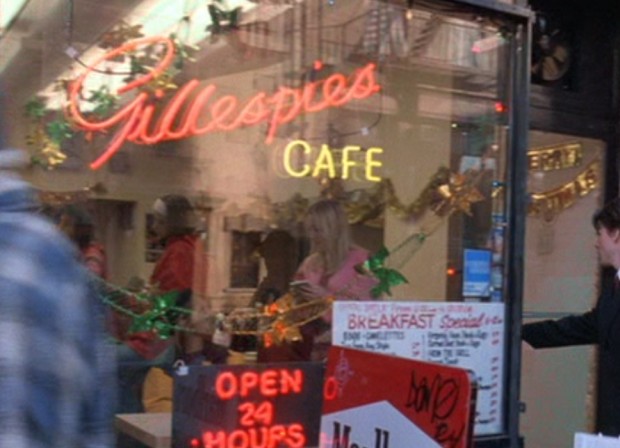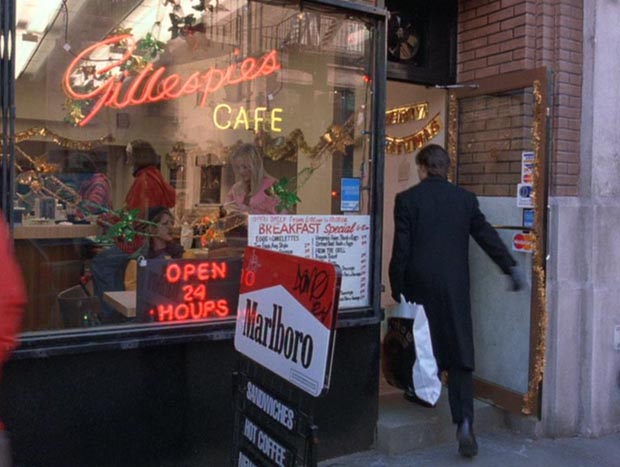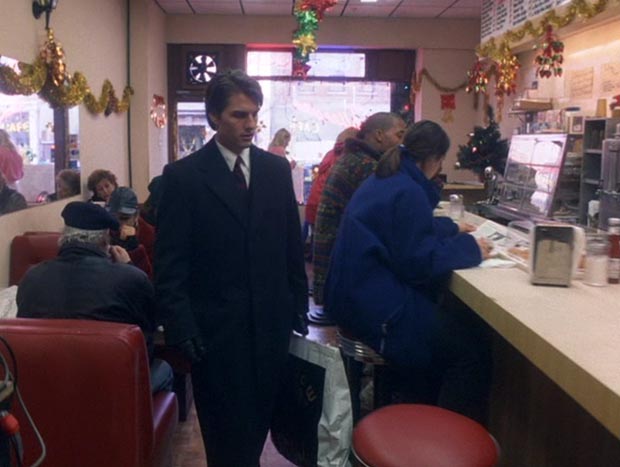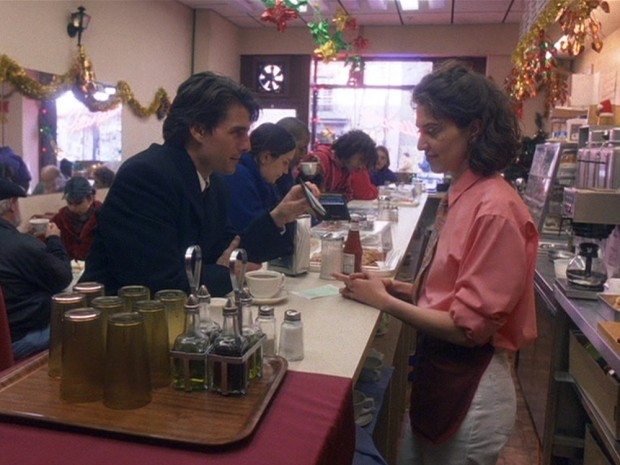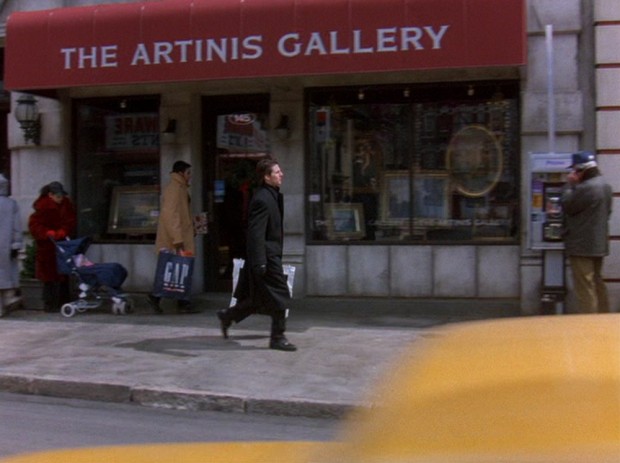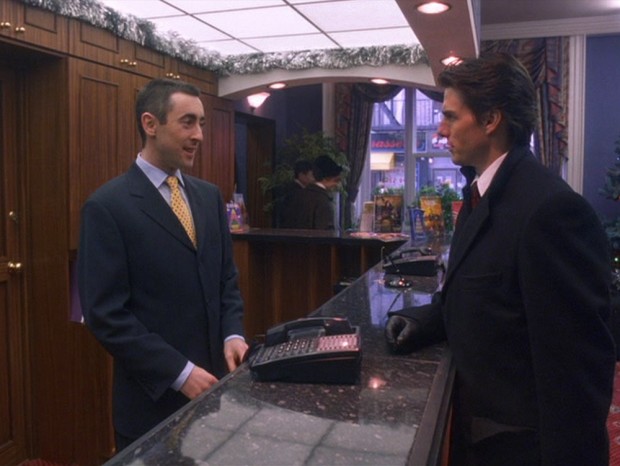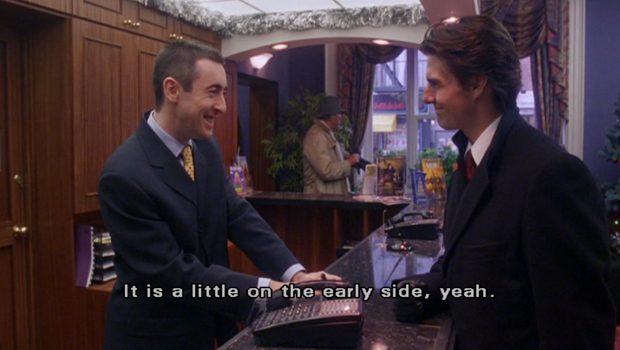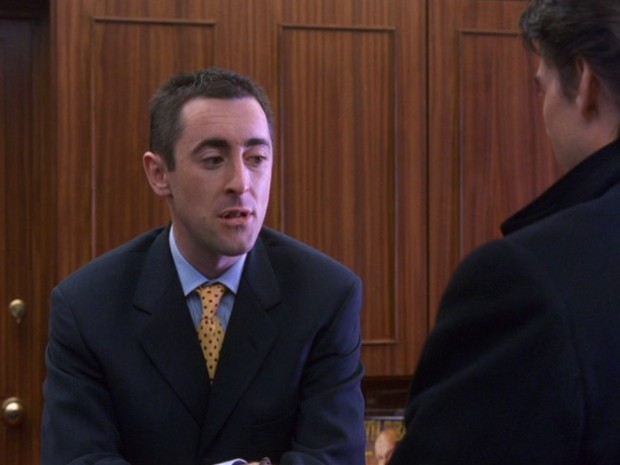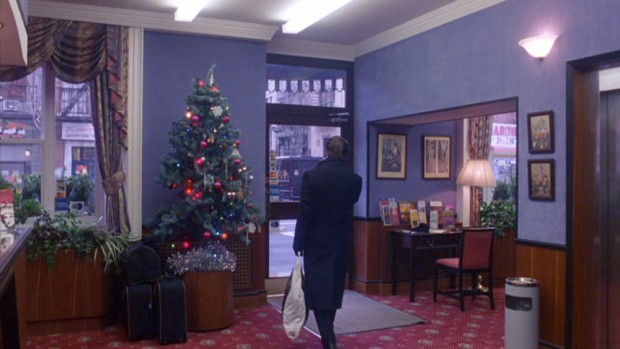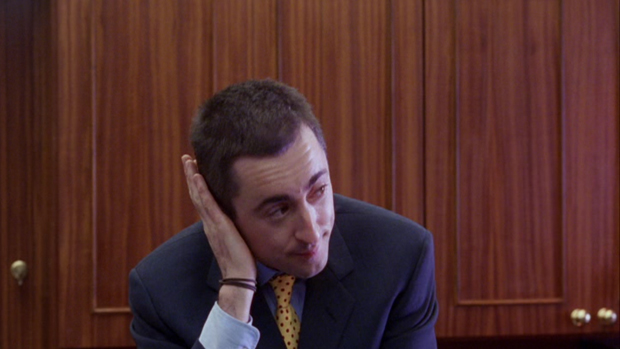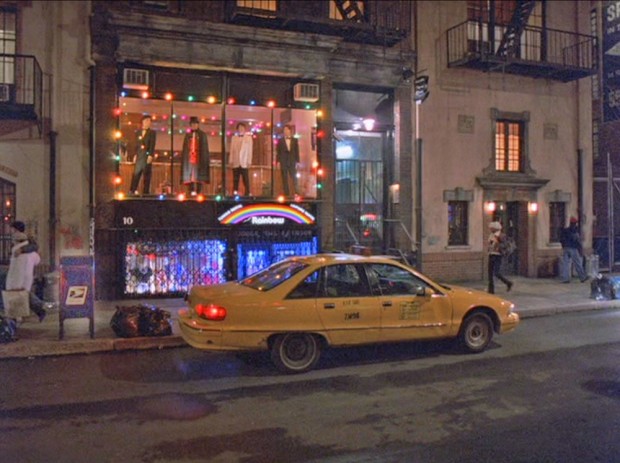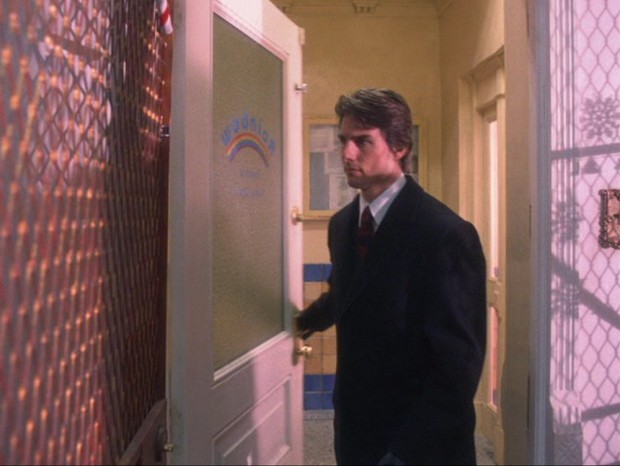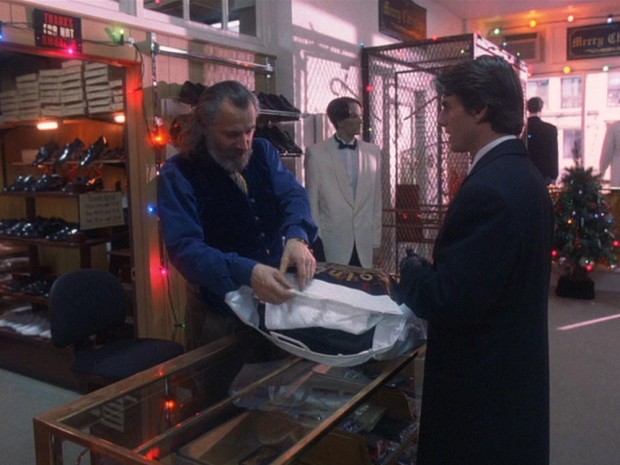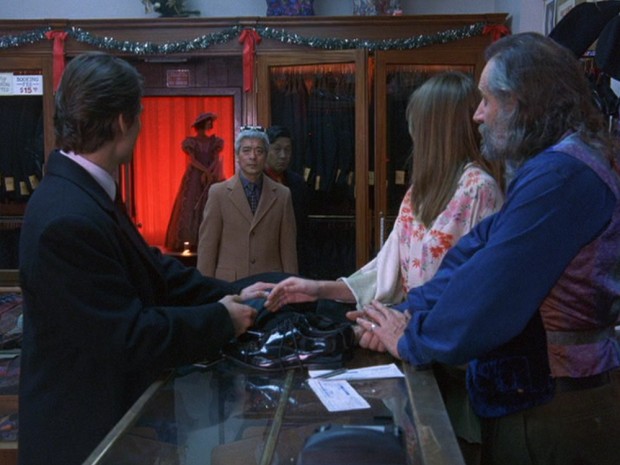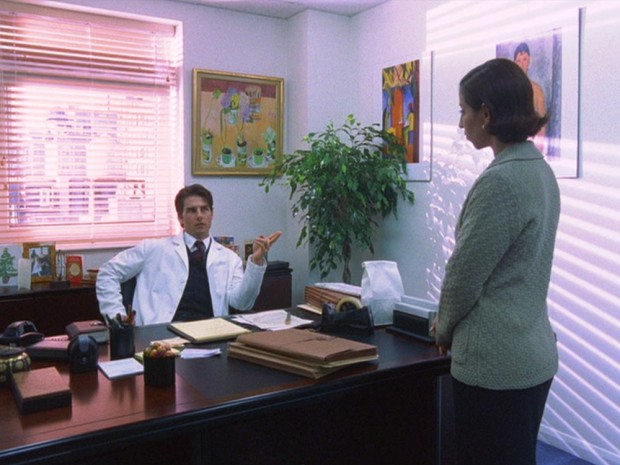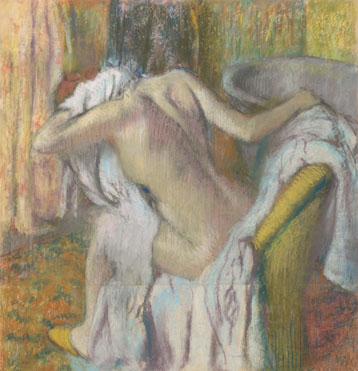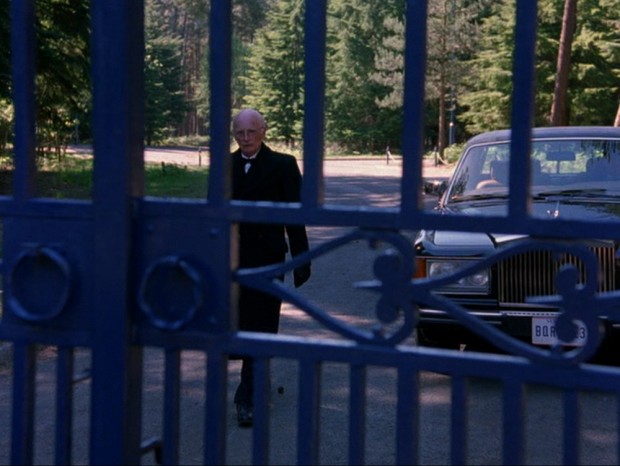STANLEY KUBRICK'S EYES WIDE SHUT

Go to TOC for this film ( (which has also a statement on purpose and manner of analysis and a disclaimer as to caveat emptor and my knowing anything authoritatively, which I do not, but I do try to not know earnestly, with some discretion, and considerable thought).
PART SIX
TOC and Supplemental Posts | Part 1 | Part 2 | Part 3 | Part 4 | Part 5 | Part 6 | Part 7 | Part 8 | Part 9 | Films Home
LINKS TO SECTIONS OF THE ANALYSIS ON THIS PAGE:
The Second Visit to Sonata Jazz Leads to Gillespie's Cafe, Shots 380 through 385
University Place. Ones and unity. Auto repair and the cab. The mysterious package. The doubled top hat. The doubled guitar. Visit to Gillespie's. To be perfectly honest.
The Hotel Jas(n) which will later be the Verona Restaurant at 237, Shots 385 through 398
110 University Place. The envelope. The missing N and 50, Ghe story of Nick's check out. To be perfectly honest. Chess.
The Second Visit to the Rainbow Costume Shop, Shots 399 through 410
The 7M96 cab and its dent. Bowman. Ace and 111. The mysterious package. The missing mask. Milich's daughter as one who is costumed.
Return to Somerton, Shots 411 through 436
Aleph. Bill's office. The paintings ofAugust Macke, Modigliani and Edgar Degas. The yellow chair. On shots 379 and 385, Universal Time and Greenwich Mean Time. The second visit to Somerton. Jericho Turnpike and Somerton. The Musica Ricercata, BQR, and inquiry. The two gates and the twisted and nontwisted gate pulls.
A handy-dandy diagram I made up of the streets Bill rambles and the various establishments he visits which are actually multiple fronts.
THE SECOND VISIT TO SONATA JAZZ LEADS TO GILLESPIE'S CAFE
UNIVERSITY PLACE, ONES AND UNITY - AUTO REPAIR AND THE CAB - THE MYSTERIOUS PACKAGE - THE DOUBLED TOP HAT - THE DOUBLED GUITAR - VISIT TO GILLESPIE'S - TO BE PERFECTLY HONEST (NOT)
SKIP ALL THIS AND TAKE ME TO THE TL;DR WRAP-UP AT THE END OF THE PAGE.
In 2001, subsequent the intermission, when Frank Poole goes EVA, from then on we have a number of shots so closely reduplicating Bowman's walk that it is sometimes difficult to tell a difference between the two. It's a repeat performance, essentially, until Poole's oxygen is cut off. In A Clockwork Orange, after his release, in his corrected state, Alex ends up returning to people and places that had figured in his life prior his incarceration and treatment. We have a repeat, then, of all those altercations, only Alex is in his corrected state and is not only unable to be violent but can't protect himself. Eventually he attempts suicide. Bill, now, following his visit to Somerset, will return to the places he had been the previous day. The point is repetition, as in a kind of Eternal Return (as figures in 2001) and the deja vu events of The Shining. If Alex met with hardship and difficulty, Bill will routinely find himself unable to connect with the people who had made an impression on him the prior day.
380 LS Fade in city Street daylight. (1:38:29 begin fade in, end about 1:38:33)
This is a real street, not a set street. We're able to place it because of the Dean & Deluca Cafe sign, which is the cafe at 75 University Place in New York. We're at the corner of E. 11th St and University Place. A red flag with a bowling pin hangs over the street.
We're going to have a proliferation of ones for a bit. University? Universe. One. A whole. Whatever the reason, we have here a real world street, University Place, at the E 11th cross street. When we next have a shot of a real world street it will again be University Place and as we have bowling pin flags prominent in both shots we will realize a common focus of both shots is the real life bowling lane at 110 University Place.
381 LS Crossfade to the Sonata Jazz/Rainbow Street. (1:38:35 begin cross fade, end about 1:37:37.)
The previous shot we were at E. 11th St. and University. Here, 11 is the street number of Mancini's.
Whereas the traffic was proceeding away from the camera in shot 380, it now comes toward the camera. The 7M96 cab passes by, which is the cab that had consistently used the previous night. It directly precedes the 7P94 cab that now carries Bill.
The ad on top of the 7P94 cab reads DKNY EYES. DKNY stands for Donna Karan New York but of course catches one's attention because of "Eyes", both due the title and the later revelation of Victor having Bill followed.
Two people carrying a Christmas tree cross before the cab as it stops. We see at the far end of the street the Thread Mills building with the C&P Auto Repair sign. Across the street is Mancinis's cheese shop. Arriving at the Rainbow the previous night, the C&P Auto Repair sign wasn't visible and the red restaurant across the street, on the corner, was the Caffe da Emilio.
And what it looked like last night when Bill was being delivered by taxi to Rainbow Fashions, supposedly a long way from Sonata Jazz.
The big Thread Mills ad is still there and the buildings to either side are much the same. 2nd Pescado is the 2nd Pescado in both views. The valance is different.
We see people walking along carrying wrapped packages and a person has a GAP bag. Bill exits the cab, pays the driver and pockets his wallet. While he is doing this we see two people in blue walk up the steps to the door of the Rainbow building and they are carrying a package that we will observe again later being carried before the Rainbow when he returns to it, and then again when he returns to Domino's. As far as I'm aware this is the first appearance of this package. It is significant because Kubrick also presented the discreet problem of a package in A Clockwork Orange. In Alex's bedroom was a parcel wrapped in brown paper set upon a baset, and on the parcel was a piece of paper. This piece of paper was likely the one he presented at the record shop. We don't know what was on it but the clerk went to check if something had arrived. When Alex enters prison, Kubrick makes a point of showing everything with which he enters and it's very little. When Alex exits the Ludovico facility, he is carrying the same brown paper parcel that was in his room. This is stolen from him when he is beaten up by the elderly. So, this mysterious reapparing package in many ways recalls that one.
Below is a cropped image showing the package carried up the steps to the Rainbow.
Bill crosses the street. As he does so, a woman in red, with a hat that resembles a top hat, passes before the Sonata. Below is a cropped image of that.
As he approaches the Sonata Cafe with the guitar sign above it, just as when he last visited it, a man with a guitar passes to the right, wearing a red and black plaid jacket.
382 MS Bill before the gate of the Sonata. (1:38:58)
Bill finds the Sonata Jazz cafe gated and locked.
Bill will continue to encounter gates closed to him in his inquiries, as befitting the warning at Somerton. And yet Bill was certainly enticed to Somerton.
In keeping with the theme of dualities, sometimes expressed in black/white one may note that part of a backing behind the Sonata Jazz sign is transparent, so it rests on black, while part is essentially white.
BILL: Shit.
He looks again at the photos on the marquee, which gives us a reflected view, in the glass, of the top hat hanging before the Rainbow across the street.
We can see that approximately the same portion of the yellow poster is shown here as was revealed the night before. The revealing of the top hat was doubled by the woman in a hat resembling a top hat, furry and black with a brim, passing before the Sonata before Bill approached it. Her hair was dark black and the hat blended into it, not standing out.
The night prior, Kubrick pushed at the audience a tantalizing glimpse of the fact that the Sonata Cafe was across the street from the Rainbow. He made it obvious, reflected neon glaring in our faces. Now, Bill at the Sonata, Kubrick does the same again, only less obviously in the daylight, the building next to the Rainbow clearly reflected in the glass.
He turns and faces the street and this time we are clearly able to see the Rainbow, the display windows of which are empty. However, Under the Rainbow is clearly there.
With Bill carrying the bag that shows the Rainbow logo, and the Rainbow shop observed directly across the street, Kubrick is making no secret that the same storefronts are being used repeatedly. It is like a maze in which one finds nearly identical paths with marginal differences.
Bill turns and goes to Gillespie's Cafe, having been preceded by a woman in a red hooded cloak of sorts. We are able to see the building beside the Rainbow reflected in the window. One is perhaps given the impression that Bill is entering not only Gillespie's but the building beside the Rainbow.
Gille - spies.
Spies. This would fit in with the idea of Bill being followed.
The number 10 pops up again and again. Here, The "Open 24 Hours" sign briefly reflects a "10" on the Marlboro sign.
We see outside of Gillespie's, more on the side of James Tobias Lomas' Realty, a trash bin. Most of the trash bins have been city bins with an 80 on them. This is instead an Ace bin.
383 MS Interior of Gillespies, Bill entering. (1:39:28)
Bill goes down to the end of the counter where he finds an empty stool and sits.
Perhaps some filming equipment briefly makes it into the shot on the left.
A woman (Carmela Marner) with brunette hair, wearing a coral color shirt and white pants, waits on him. She wears a necktie, which is perfectly normal on a woman but I think Kubrick is bringing up the subject of gender reversals, for next door is the Sonata, modeled on a drag club, and at the Rainbow the night before we'd had suggestions of drag with the Japanese men in their wigs, and at Somerton, as Nick was being led out, we had women in tuxedoes dancing.
When Bill had been accosted by the Yalies they had referred to him as being a switch-hitter, on the pink team. The woman in the light coral color shirt, has a kind of mole on the same side of her face as Bill's, in about the same position.
WAITRON: Hi.
Bill: Hi. I'll just have a cup of coffee, please.
WAITRON (pouring the coffee for him): Anything else?
BILL: No, thank you.
The waitron writes Bill the check.
BILL: Excuse me. Would you happen to know when they get in next door at the Sonata Cafe?
WAITRON: There's usually someone in the office around two or three.
BILL: Two or three. Uhm. (Delaying her.) I uhm...I don't suppose, by any chance, you know Nick Nightingale. He's playing piano over there right now.
The address for the Sonata is 3. Domino's apartment was 3, right next to 2, which couldn't be an apartment as the Lotto store occupied its area. Later, when Bill returns to Domino's, he'll be briefly uncertain which door is hers, whether it is 2 or 3. I note this because the waitron expresses the same uncertainty over 2 or 3.
WAITRON: Nick Nightingale. Sure. He comes in here.
BILL: Well, look, uh...maybe you can help me because it's very important that I get in touch with him this morning. Do you know where he's staying?
WAITRON: Well, uh...I I don't know if he'd want me to give out his address.
BILL: It's okay, I'm a doctor. (He pulls out his billfold and ID.) I'm actually a very old friend of his.
384 MS The waitron seen from Bill's right. (1:40:48)
Behind her we view the blackboard with the day's specials: Boiled filet, another kind of fish, fish cakes, hot oven turkey. For soup there's clam chowder and chicken noodle. The menu partly fits with the idea of Lent, which follows carnival season, and the ban against eating meat, for which reason fish, though we have turkey and chicken on the menu and that kind of "fowls" that up. Or maybe not as there is no red meat.
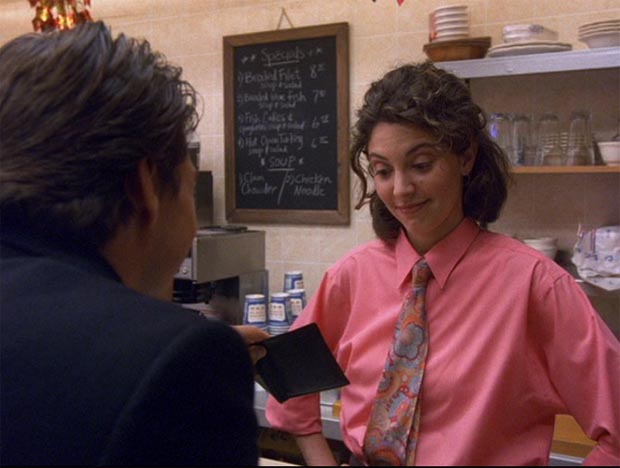
WAITRON: Well, doctor, uhm, he'll be playing there tonight. Can't it wait until then?
385 MCU Bill putting up his wallet. (1:40:57)
BILL: Listen, to be perfectly honest, it's a medical matter. Some tests. And I know he'll want to know about them as soon as possible.

To be perfectly honest?
Bill has used his wallet again, his id, as his password. When he meets reluctance he strong arms with a lie about medical tests. He's suggesting that he has bad news for Nick and one might imagine HIV positive. Nick isn't his patient, but if he was Bill is breaking confidentiality here. Later, this is mirrored back to him when he's told Domino got her test that day and is HIV positive.
THE HOTEL JASO(N) WHICH WILL LATER BE THE VERONA RESTAURANT AT 237
110 UNIVERSITY PLACE - THE ENVELOPE - THE MISSING "N" AND 5 0 - THE STORY OF NICK's CHECK OUT - TO BE PERFECTLY HONEST (BACK AT YOU, BILL) - CHESS
386 LS City street. (1:41:11)
This is another live street shot rather than set. It is at the corner of E. 13th St. and University Place looking back down in the direction of Dean and Deluca, the Bowlmor Lanes here at 110 University Place. This is just a few blocks from the last exterior non-set shot at East 11th and University. Bowlmor lanes was the reason for the red flag showing the bowling pin hanging over the street in the 380 shot.
So, we have these two scenes hinging Bill's search for Nick around Bowlmor lanes at 110 University. Coincidentally, Bowlmor was originally started and owned by a man named Nick and was quite famous.
387 MS Bill walking down a sidewalk. (1:41:17)
Bill passes a storefront with KPS in its windows, the door being 147. Before 145, which is The Artinis Gallery, a man with a Gap bag passes and a woman with a pram follows.
He enters the Hotel Jason (the "n" isn't seen on the sign) which has two globe lights out front decorated with the number 143. This, and Artinis, will later be the Verona Restaurant with a street number of 237. The Jason is obviously based on the Washington Square hotel located at 101-105 Waverly Place.

Again, another 101. A permutation of 110.
The Washington Square Hotel was built in 1902 and originally named the Earle Hotel for the owner, Earl S. Lamoureux.
Where is Seattle, where Nick lives? In the state of Washington.
The etymology of Jason from the Online Etymology Dictionary:
masc. proper name, from Gk. Eason, from Heb. Yehoshua, a common name among Hellenistic Jews (see Joshua). In Greek mythology, son of Aeson, leader of the Argonauts, from L. Jason, from Gk. Iason, perhaps related to iasthai "to heal." The names were somewhat merged in Christian Greek.
In Section One, due what I took to be the symbolic language implied in some set changes, I compared Amanda to the prostitute Rahab who took the spies into her house when Joshua was preparing to conquer Jericho and kept their plans a secret. In Section Five, via the real life Somerton being a place with a classical labyrinth based on the legendary labyrinths of Troy and Jericho, I endeavored to show how we have echoes of Troy and Jericho in the film. Here, we have Joshua who led the destruction of Jericho. Or maybe not. What I know is we have had Jericho and Troy and the maze. JASO is up for grabs.
I have already discussed Aeson's visit to the underworld and that Kubrick has this myth in Barry Lyndon.
Jason and the Argonauts. The Argo was the ship they traveled on but Argos was the name of the all-seeing, many-eyed giant. As Wikipedia states, "the figure is known for having generated the saying 'the eyes of Argus', as in to be 'followed by the eyes of Argus', or 'trailed by them', or 'watched by them'. (A son of Jason and Medea was Argus/Argos.) This watchfulness, the being followed, fits with Bill's realizing he is being trailed, and Ziegler later confirms he had him watched. In this scene, Bill will be asked if he is himself a detective, 5-0. We see on the counter behind the hotel clerk a magazine cover showing a bald man looking out at the camera, who we will later be reminded of when Bill is followed by the bald man.
388 LS Interior of the Hotel Jason, Bill entering. (1:41:31)
Bill passes by a woman writing at a desk and goes to the counter. On the other side of the door is a Christmas tree with a number of black bags beside it, reminding of the Christmas tree at Victor's that had the black drape tucked behind its base. My idea is that these draperies and cases referred to the black cloaks worn at the Somerton ritual.
BILL: Excuse me.
Notice a couple in the background who exited the beyond doorway when Bill approached the desk and left. In the next shot they will again exit the same doorway and leave. Kubrick did this several times in 2001, backing up and repeating, and he has done so earlier in Eyes Wide Shut, such as the taxi driving him twice by the place with 1:22 on the clock as he headed over to Marion's after his argument with Alice.
389 MS The clerk turning to Bill, away from the mail and key slots for the rooms. (1:41:39)
This action, the clerk putting the envelope in the cubby, anticipates the later scene in which the older man, at Somerton, slips Bill the envelope with a message.
We see the same couple who had left in the previous shot, emerging from the same doorway and leaving again.
The clerk at the reception desk, played so he is obviously gay and attracted to Bill, eyes him up and down appreciatively and asks how he can help him.
CLERK: Hi, how can I help you?
BILL: Can you please ring Mr. Nightingale's room for me? Nick Nightingale.
CLERK: I'm sorry, sir. Mr. Nightingale has already checked out.
BILL: He checked out?
CLERK: Yes.
BILL: Uh, did he leave a forwarding address?
CLERK: No, I'm afraid not, no.
BILL: When did he check out?
CLERK: Uhm, about five o'clock this morning.
BILL: Five o'clock.
CLERK: Yes.
BILL (smiles): That's a pretty early check out, isn't it?
CLERK (flirtatious): Uh, it is a little on the early side, yeah.
Are we getting this stress on "early" as the hotel is modeled after what was the Earle Hotel?
This is the only conversation in the movie in which the word "clue" is used (a few shots down). And the clerk asks Bill if he's a detective. In the background we see an individual pass by who is dressed as Peter Seller's Clouseau from the Pink Panther films. The thing about Clouseau is that he was a lousy detective who overlooked the obvious, which is the same that has been said about Bill.
If there is a Pink Panther reference it could be looked upon also as referring back to when Bill walked past the Pink Pussycat, before his encounter with the frat boys who abused him for being gay.
BILL: Look, uh...
390 MCU Bill, the elevator behind. (1:42:20)
BILL: ...did you notice anything, uh, I don't know, unusual about him when he left?
391 MS Clerk. (1:42:28)
There had been hotel policy signs before on the door that is partially visible behind the clerk. These perhaps are gone now. In close-ups, the clerk is now wearing a leather bracelet, a thin band wrapped three times about his right wrist, which isn't there in the opening long shots or in the long shot at the end, though it is seen again in the final close-up when he sweeps his hair back with that hand at his temple. It occurs to me the leather wrapped around his wrist could be a reference also to the clue of a maze.
CLERK: Unusual? Hey, you're not 5 0 are you?
5 0 refers to the old show, Hawaii 5 0, so the clerk is asking if Bill is a detective. If we care to look at Tree of Life/Tarot attributions we have the letter Nun, meaning fish, and the Death card. A kabbalistic interpretation is that as NN concerns the fish, it also concerns water and a purification through suffering, just as the world was purified by the the flood.
Only the letters JASO are shown out front of the hotel's name. I can't imagine it ending in any thing other than N.
In the screenplay, Bill had asked Nuala if her name was Hawaiian.
BILL: No, I'm an old friend of his.
CLERK: Really.
BILL (getting out his ID card): I'm a doctor.
CLERK: Oh. (Looks at the card and bats his eyelashes.) Well, uh, Bill?
BILL: Sure.
CLERK: It's funny you should ask that question, uh, Bill, because actually there was something a little strange about the way Mr. Nightingale left, yes.
BILL: Really. What, what was that?
CLERK: Uhm, well. (He leans in toward Bill and whispers.) He came in this morning about 4:30 a.m. with two men. Big guys. I mean, they were very well dressed, and very well spoken, but they weren't the kind of people you'd like to fool around with. If you know what I mean. (He smiles and touches Bill's hand and then, breaking into an embarrassed smile, covers his face briefly.) Anyways, uhm, I noticed Mr. Nightingale had a bruise on his cheek, and, uhm, to be perfectly honest, I also thought he looked a little scared.
To be perfectly honest. Bill has used this phrase with the woman at Gillespie's, but had told her a lie. Now the phrase is used with him and one has to wonder what amount of the story Bill is being told is the truth.
Big guys. This comes up a number of times, the big guys who appear to act as bullies or constrainers. Giants are also associated with the NPhL, fallen, overthrown ones, or tyrants. This may fit with the film in the context of the mythic story of the rainbow/flood, which is already addressed in sections one and five.
392 MCU Bill. (1:43:47)
BILL: Scared.
393 MS The clerk. (1:43:49)
Victor will later say he had Bill followed and that he knows of his conversation with the clerk. Here we have briefly a magazine showing part of a face of a bald man behind the clerk. This magazine isn't there in any of the longer shots. But the face of the bald man would seem to connect with the idea of Bill being watched by the bald man he later becomes aware is following him.
CLERK: Yeah. Yes, yes. He, he said he wanted to check out, and then went upstairs to his room with one of the men. And the other guy stayed down...
394 MCU Bill. (1:44:00)
CLERK: ...in the lobby and settled his bill.
395 MS Clerk. (1:44:02)
CLERK: And then when they came back down, Mr. Nightingale tried to pass me an envelope, but they saw it and took it away and said that any mail or messages for him would be collected by someone properly authorized to do so. And then they just took him off in a car. (He grins, both nervous and flirtatious.)
396 MCU Bill. (1:44:21)
BILL: Do you have any idea where they went?
 389 |
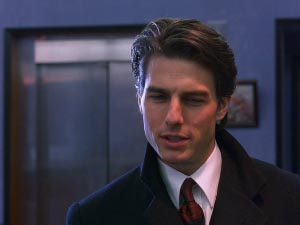 390 |
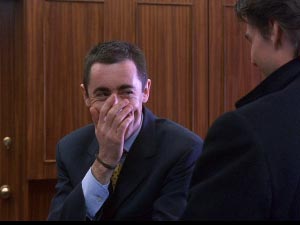 391 |
 392 |
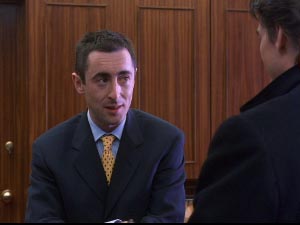 393 |
 394 |
 395 |
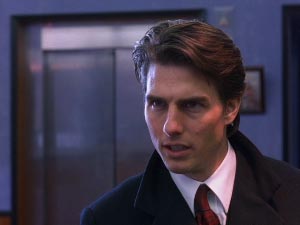 396 |
397 MS The counter with the clerk on one side and Bill on the other, a view of the street through the windows beyond. (1:44:23)
CLERK: No, not a clue.
BILL: Uhm. Well, anyway, certainly (he picks up his bag) I certainly appreciate your help.
CLERK: Oh, any time, Bill. Bye.
As Bill leaves we get a clear shot showing that the Hardware/Paint shop is across the street, as is the Rainbow shop (beyond the van seen through the front door). The hotel is represented as being elsewhere in the city when in fact it is in this same maze of a neighborhood that only partially morphs via changing facades. The Hotel Jaso() would seem to be in the same spot as the later observed Verona Restaurant, during the scene in which the Rainbow shop has been transformed into Sharky's, and Bill has a face off with a burly, bald fellow. The Verona Restaurant has the address 237, which recalls the feared room 237 from The Shining.
398 MS The clerk. (1:44:44)
The clerk slides his hand back over his face and hair. This has always stood out to me.
We see here, I think, a reference to 2001, a scene of a discussion between Heywood and the Russian, Smyslov, in which Smyslov strokes his hair in the same manner, and the ceiling above in the Space Station is the same ceiling above the clerk in this hotel. Smyslov (named for a famous chess player) had been digging for information about what was happening on the moon, communications cut off, bringing up the supposed "epidemic" that was rumored to have broken out. Heywood had dodged giving him information about the monolith by saying he couldn't talk about what was happening, thus giving the impression there was an epidemic. As Smyslov was questioning Heywood a woman had passed by behind him, an attendant dressed in pink, and Smyslov had lowered his voice as if worried about being over heard.
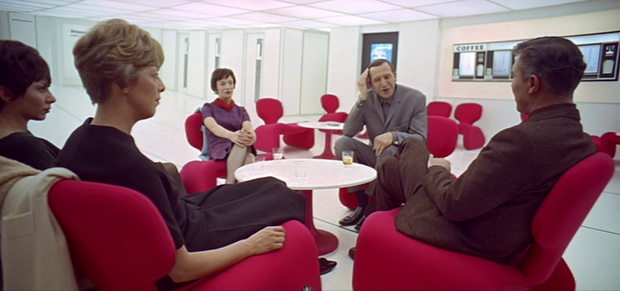
What stands out most to me are the clerk's gestures and the ceiling tying back to shots 141 and 142 in 2001 in which Smyslov smoothes his hair and the woman in pink walks behind him and he drops his voice, worried about being overheard. 141 and 142 are awfully close to the street number of the hotel, 143. What occurs during shot 143 in 2001 is Floyd several times insisting he's not at liberty to discuss the matter (of the supposed epidemic) and then cutting off the conversation and saying he must be going. 141 is particularly important as my belief is that it is referred to again at the end of 2001, in the hotel room with Bowman, which relates to the earlier scene between Smyslov and Heywood as it occurred in an area of the space station where we see a Hilton hotel registration desk, and thus connects also to this scene with Bill being at a hotel. Also, in the infinity hotel scene, the illuminated tiles of the floor can be understood to be what had been the illuminated ceiling tiles in the scene with Smyslov and Heywood, who are having their discussion in the Djinn chairs. There has been a 180 degrees inversion, a flip, so the ceiling becomes the floor.
Kubrick enacts part of HAL's chess game on that illuminated floor in 2001 after giving it an 8x8 chessboard layout in one shot, and I describe this at length in my analysis of 2001. That same chess move is played out in The Shining on the hotel carpet outside room 237 in the few shots where the carpet seems to be reversed 180 degrees and then to have reoriented to the original layout. Remember that this hotel from which Nick has disappeared will later become the location of the Verona restaurant that will have a street address of 237.
The chess move that is reenacted in the infinity hotel room, part of the game that had occurred earlier between HAL and Frank Poole, is the moment at which Frank moves his rook from F1 to E1 and HAL says, "I think you missed something." Due this game we learn and his description of the moves, we learn that HAL is seeing from two perspectives at once, both his own and Frank's, for he describes things from Frank's perspective on the board. He then gives the oracle concerning the failure of AE35.
In the scene where Nuala and Gayle tell Bill, "But I bet they work too hard [doctors]. Just think of all they miss," they then state they are taking him to where the rainbow ends, at which point Victor's butler (himself a big guy) interrupts and takes Bill up to the bathroom and the overdosed Amanda.
Outside the door we see the hardware store and the facade of Rainbow Fashions. Is the audience being directed to what they might have missed?
THE SECOND VISIT TO THE RAINBOW COSTUME SHOP
THE 7M96 CAB AND ITS DENT - BOWMAN - ACE AND 111 - THE MYSTERIOUS PACKAGE - THE MISSING MASK - MILICH'S DAUGHTER AS ONE WHO IS COSTUMED
399 Exterior city street shot. (1:44:49) Paul's Da Burger Joint places this at 2nd Avenue and St. Mark's Place.

400 Exterior The Rainbow. (1:44:53)
If one pays attention to the mail receptacle boxes, we will see the blue postal boxes on the street now bearing identical graffiti, appearing to be the same box from place to place. Before Bill's visit to Somerton, the postal boxes were free of graffiti. One may wonder if there's a connection to the hotel and the desk clerk telling Bill about Nick's failed attempt to leave an envelope and that "any mail or messages for him [Nick] would be collected by someone properly authorized to do so". We can't make sense of the grafitti. Has it anything to do with Nick's failed communication and the idea that only appropriately authorized individuals would be receiving messages?
A cab pulls up before the Rainbow shop and lets Bill out. He again appears to be in the 7M96 cab. One way we're able to tell is by the squeal it makes, and another is that its passenger door is dented in, and had been dented in the other night when we first saw it from this angle, when it was dropping Bill off at the Rainbow. When Bill had his "collision" with the Yalies, he had fallen into a car. That car was blue and he had fallen against the driver' side, but I imagine that blue car refers to this.
We see the hardware store just beyond, which is the store before which he encountered the prostitute, and we are able to see on it in large letters an ad that reads MANNING and below that BOWMAN, which brings in Dave Bowman of 2001.
On the side of the building is an ad that reads in part:
...(P)ACE
...HIS AREA
...ERLEY
...PRING ST
...5-3111
Ace is all that is really seen above, the P only partly observable and SP being further implied. We had earlier, in front of JAMES TOBIAS REALTY, beside Gillespie's seen a trash bin which stood out as different as it read Ace, whereas the city bins have 80 on them. 80 is the gematria for P (or ph). As the bin stood out as different, being an Ace bin, and now we have (p)ace on the side of this building it would seem notable.
In the previous scene at the Jaso(n) the subject had been brought up how Nick Nightingale had checked out early, and perhaps that could tie in with the "erley" in the sign. Plus, the Hotel Jaso(n) was based on the Earle Hotel (then Washington Square hotel).
As Bill goes up the steps to the store, the 7P94 cab with the DKNY ad atop passes by, which is the cab that had delivered Bill near the "hidden" Rainbow in shot 381. A woman carrying a box enters the frame on the left. It is the same package we had seen in shot 381 when Bill was getting out of it and two individuals had climbed the stairs to the hidden Rainbow (the storefront being vacant and having nothing in it). When Bill goes to Domino's later, another woman will be carrying this package out of her building.
We see that one of the mannequins in the window is no longer wearing red, as it had been the previous evening. If one considers the mannequins, in their black tuxes and white dress coats, we might look upon all the men in their tuxes at Victor's party as having been in costume, and that Nick in his white coat was in costume as well.
Note also that today we have the street number 10 not only showing on the left of the Rainbow, as the previous night, but we also have 10 now on the door, and this 10 wasn't on the door the previous night.
401 MS Bill entering the Rainbow shop. (1:45:12)
As Bill enters the shop we see a second set of entry doors outside in the hall, a set of cream colored doors. These are seen the previous night as well when Bill is entering the shop. They are not however seen from the street, as shown below. And, actually, the layout of the Rainbow is such that it denies the feasibility of the design of the hall below.
So, Bill enters the store and goes to the counter. Milich is there, dressed in a blue shirt with a blue velvet vest. The pattern on his tie appears to be a mock snakeskin.
MILICH: Oh, the good doctor!
BILL: Mr. Milich.
We see that the stance of the mannequin beside the security gate is different from the previous evening.
Where there were shirts beside the mannequin beside the security gate the night before, there are now shoes, and a second counter is located there, whereas the previous evening there had only been one counter located before the wall cases holding the suits.
MILICH: Was your outfit a success?
BILL: Yes, it was, thank you.
MILICH (pulling items out of the bag): Good, good. Tuxedo. Cloak. Shoes. Uh...I think, uhm, you forgot the mask.
BILL: It's not there?
MILICH: No, no, no. Maybe you left it at the party.
402 MCU Bill. (1:45:48)
BILL: Uh, I don't think so. (Smiles.) I must have lost it. Could you just put it on the bill, please.
403 MS Milich. (1:45:59)
MILICH: Sure. (Opens the cash register and takes out the bill.) Here we are. That was one hundred and fifty for the rental, two hundred you said for my trouble, twenty-five for the mask. Sorry. That's five, six, three-hundred and seventy-five.
Why "five, six" I don't know as six shouldn't appear in the addition. So, my mind turns back to Amanda who had been out for about five to six minutes when Bill was shown to Victor's bathroom at his party.
404 MS Bill and Milich from the right of the counter. (1:46:20)
Beyond we see the door between the two cases of tuxes. Some of the tuxes had not just the small tags but very large tags on them the previous night and these are now gone.
The door opens and the owner's daughter exits, still in her lingerie and the little wrap that she'd used to cover herself with the night before, when caught with the two men. She looks startled to see Bill.
MILICH: Yes, dear, come, come. Would you like to say hello to Dr. Harford?
She advances to hold hands with her father and shakes hands with Dr. Harford.
GIRL: Hello.
BILL: Hello.
The two men from the previous night exit, very well-dressed. Both also looking a little surprised to see Harford, as he is them.
JAPANESE MAN ONE: Good-bye, Mr. Milich. I'll call you soon. (Waves at the girl.) Bye-bye.
The second Japanese man throws a kiss at the girl.
MILICH: Good-bye, gentlemen.
405 MCU Bill from behind Milich. (1:46:45)
MILICH: Merry Christmas and Happy New Year!
JAPANESE MAN ONE: And you, too.
Bill stares on in disbelief, the owner giving him his receipt and thanking him for his business.
MILICH: Well, Dr. Harford, here is your receipts. I'm tearing up your deposits.
406 MCU The girl. (1:46:58)
407 MS Bill, Milich and the girl from the right of the counter. (1:46:58)
MILICH: And thanks for the business.
BILL: Mr. Milich. Last night, you were going to call the police.
MILICH: Well, uh... (He scratches his beard and neck.)
408 MS The girl and Milich from Bill's right. (1:47:16)
MILICH: Things change. We have come to another arrangement. And, by the way, if the good doctor himself should ever want anything again, anything at all (he puts an arm around his daughter, hugging her to him)...
409 MCU The girl with her father's hand on her shoulder. (1:47:30)
MILICH: ...it needn't be a costume.
410 MS Bill from behind Milich's left shoulder. (1:47:31)
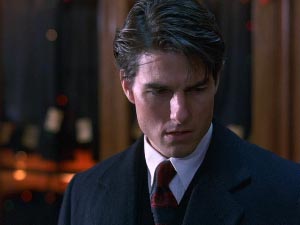 402 |
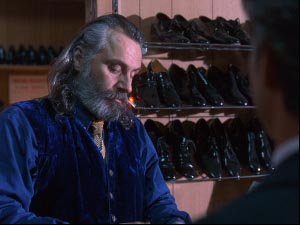 403 |
 404 |
 405 |
 406 |
 407 |
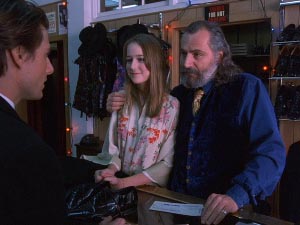 408 |
 409 |
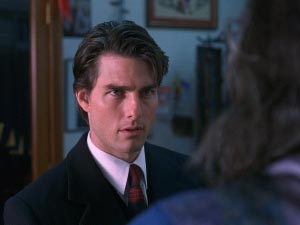 410 |
|
The girl's face is very doll-like, as I've already mentioned in an earlier section. One could take it that as the shop owner wraps his arm around his daughter with the mention of the costume, he is not so much selling her as referring to the idea of costuming, as if she is herself presently costumed.
Which is the read I have to take on this after a good deal of examination.
Bill doesn't call the police in response to the seeming pimping of the girl. He seems helpless to do so after having attended the party the previous night, even though he has no reason at this point to associate Rainbow Fashions with anything he had experienced at Somerton. At Nick's hotel he had just had to identify himself as not being police; he has heard what is disturbing news about Nick and yet he won't call the police about Nick. He also won't call the police about this girl, or later about Mandy, and Kubrick leaves us to struggle with whether it is less a moral failure than Bill's ultimately recognizing that things are not as they seem. At this point in the game, his world is so unsettled, however, that it may be he has simply lost his bearings on interpreting the truth of anything around him.
Still, as I noted, when Milich puts his arm around his daughter and says "costume" I am taking this to mean that what we see here is a costume.
RETURN TO SOMERTON
ALEPH - BILL'S OFFICE - THE PAINTINGS OF AUGUST MACKE, MODIGLIANI AND EDGAR DEGAS - THE YELLOW CHAIR - ON SHOTS 379 AND 385, UNIVERSAL TIME AND GREENWICH MEAN TIME - THE SECOND VISIT TO SOMERTON - JERICHO TURNPIKE AND SOMERTON - THE MUSICA RICERCATA, BQR, AND INQUIRY - THE TWO GATES AND THE TWISTED AND THE NONTWISTED GATE PULLS
411 LS Exterior city street in a business area. We see Met Life on one of the buildings. (1:47:33)
First we had the shot of E11th and University Place (unity), then we had 110 University Place. The Washington Square hotel, on which the Jason was based, has the street address 101. Outside the Rainbow (which shows 10 on the building and 10 on the door beside) on the hardware store we saw 111 and Ace (1). Here, other than the MetLife/Panam building above Grand Central Station, what do we see but the truck labeled Alpha, which is Aleph, one, or (spelled out) 111.
Aleph is the number of the 11th path, the source of all paths, the path of the Fool.
The location is Park Avenue and East 57th Street.
412 MS Bill behind his desk at the office. (1:47:38)
Music.
Cut to Bill seated in his office, troubled, facing the window, hand to his mouth. But he's not thinking about the girl at Rainbow Fashion's, he's envisioning the naval officer having intercourse with his wife.
413 MS Alice and the Naval officer having sex. (1:47:41)
414 MS Bill behind his desk. (2:47:50)
There's a knock on the door and the music fades as Bill turns to face his desk.
BILL: Come in.
415 MS The office door opening and his secretary entering. (1:48:00)
She carries a white bag.
LIZA: Tuna salad and black coffee? (She sets the bag on his desk.)
BILL: Yes. Listen, how's my afternoon looking.
LIZA: I think it's just Mrs. Akley at 2:30 and Mrs. Kaminsky at 4.
BILL: Well, look, something has come up and I'm not going to be able to see them. Please ask Dr. Miller if he can fit them in, otherwise just apologize and make new...
416 MS Liza. (1:48:22)
BILL: ...appointments.
LIZA: Sure.
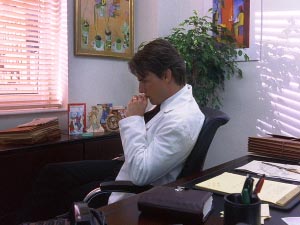 412 |
 413 |
 414 |
 415 |
 416 |
|
417 MS Bill. (1:48:25) Bill before his office window, the blinds of which cast a pink tint.
One of the cards behind him shows a seated Santa in his red suit, recalling the seated red figure in the card at his home after the secret orgy and the heirophant in red. Perhaps expressive of Victor having Bill followed.
BILL: And, uh, please call the garage and have them get my car out in half an hour.
LIZA: No problem.
BILL: Okay?
LIZA: Sure.
Liza exits.
Now, to take a look at the paintings in Bill's office. The one in the front office that shows the "7" with the several figures in red beneath is by August Macke, who was one of the leaders of the German Expressionist group, The Blue Rider. It is "View into a Lane" done in 1914 (the year of his death).

If we compare the "View into a Lane" painting above with the one in Bill's office, we see that it has been altered, cropped on all four sides so we have a closer focus on the figures in the painting.
Here in Bill's office we see a couple of other paintings by Macke. In the hall outside is "Fashion Store Window". This may remind of Rainbow Fashions.

Immediately to the left of the door is "Lady in a Green Jacket".
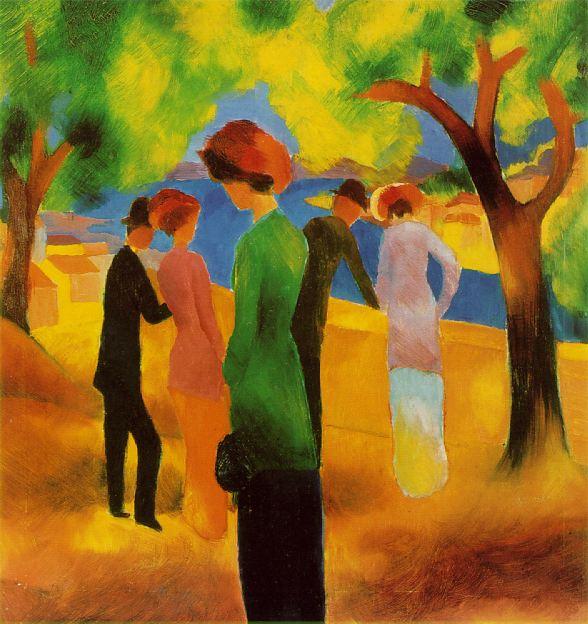
And then toward the corner is "Turkish Cafe II", I think done in 1914. The Turkish cafe painting seems from the same grouping as "View into a Lane". In the book, the dream that Albertine relates has Fridolin searching a Turkish bazaar for rich clothing and jewels for her before his crucifixion.

There are several versions of "Fashion Store Window" and Kubrick has chosen the one in which the woman wears a green jacket, and Liza is herself dressed in a green jacket. One may connect this with Rainbow Fashions and Liza carrying in a white bag for Bill, he having just dropped off the bag at Rainbow Fashions and it being discovered the mask was missing.
In every one of the August Macke paintings the people face away from the viewer.
From 1911 it could be said that European avant-garde art was divided between two needs: the need for individual subjective expressiveness and a striving for order in a time of pending chaos. Both needs were rotted in a desire to escape through an inward journey into feelings or an ideal structure. Both needs were part of the culture shock that swept Europe at the beginning of the century, as the implications of the Industrialization were sinking in. The avant-garde artists tried to create a new language to respond to these needs: the Cubists searched for a near scientific logic to the construction of the world and the Expressionists sought the answer in the irrational and a return to a more primal spiritual state.
Der Balue Reiter combined two currents: the general European Expressionism and French Fauvism and added to these currents an interest in inner and mystical construction, stemming from Theosophy. Despite the close affinity between Der Blaue Reiter and the Fauves, the approach to art making was radically different—the French artists were more interested in a formal extension of Post-Impressionism while the German artists were interested in mysticism, which was alien to the French. The French Fauves wanted to form an imaginative counter-reality through the formal elements to break up objective reality. In other words, the Fauves used Post-Impressionism to counter Impressionism and cultivated pictorial devices of pure color and pure line.
The bridge between the mysticism of Der Blaue Reiter and the French Fauves was Vincent van Gogh.
Source: arthistoryunstoffed.com / Der Blaue Reiter Painting by Jeanne Willette
In a letter of 1911 to August Macke, Franz Marc addressed his friend with a nobilitating "August Vonderfarbe" (as who should say, Monsieur de Couleur), very aptly characterizing Macke's principal artistic concern. The two had met the year before in Munich. Their friendship, by which their art mutually profited, brought Macke in contact with the painters of the Blauer Reiter (especially Wassily Kandinsky and Alexei von Javlensky). However, Macke never shared their tendency to mystical considerations and metaphysical speculation. Rather than attributing abstract values and significances to colors as Marc did, Macke used them solely to express his own personal feelings and ideas.
Source
In 1910, through his friendship with Franz Marc, Macke met Kandinsky and for a while shared the non-objective aesthetic and the mystical and symbolic interests of Der Blaue Reiter.
Macke's meeting with Robert Delaunay in Paris in 1912 was to be a sort of revelation for him. Delaunay's chromatic Cubism, which Apollinaire had called Orphism, influenced Macke's art from that point onwards. His Shops Windows can be considered a personal interpretation of Delaunay's Windows, combined with the simultaneity of images found in Italian Futurism.
The exotic atmosphere of Tunisia, where Macke traveled in 1914 with Paul Klee and Louis Moilliet was fundamental for the creation of the luminist approach of his final period, during which he produced a series of works now considered masterpieces. August Macke's oeuvre can be considered as Expressionism, (the movement that flourished in Germany between 1905 and 1925) and also his work was part of Fauvism. The paintings concentrate primarily on expressing emotion, his style of work represents feelings and moods rather than reproducing objective reality, usually distorting colour and form.
Macke's career was cut short by his early death at the front in Champagne in September 1914, the second month of World War I. His final painting, Farewell, depicts the mood of gloom that settled after the outbreak of war. (From wikipedia)
Four years, from 1910 to 1914, is almost no time at all. Macke would have still been experimenting and working toward some knowledge of himself and where his interests were leading him.
This may be what we're looking for in Kubrick's choice for so many paintings by Macke.
Masks - by August Macke
A sunny day, a cloudy day, a Persian spear, a holy vessel, a pagan idol and a wreath of everlasting flowers, a Gothic cathedral and a Chinese junk, the bow of a pirate ship, the word “pirate” and the word “holy,” darkness, night, spring, the cymbals and their sound and the firing of armored vessels, the Egyptian Sphinx and the beauty spot stuck on the pretty cheek of a Parisian cocotte.
The lamplight in Ibsen and Maeterlinck, the paintings of village streets and ruins, the mystery plays in the Middle Ages and children frightening each other, a landscape by Van Gogh and a still life by Cezanne, the whirring of propellers and the neighing of horses, the cheers of a cavalry attack and the war paint of Indians, the cello and the bell, the shrill whistle of the steam engine, and the cathedral-like quality of a beech forest, masks and stages of the Japanese and the Greeks, and the mysterious, hollow drumming of the Indian fakir.
Is life not more precious than food and the body not more precious than clothing?
With a creative couple there doesn't have to be a cross-fertilization of ideas, and we see many of Kubrick's themes in his work prior his meeting Christiane, still one wonders how much of an influence Christiane might have had on Stanley and vice versa? What of her Homage to Van Gogh and Kubrick's inclusion of Macke who was influenced by Van Gogh and the quest for the mystical in art?
A Van Gogh was also in Lolita, a landscape Charlotte pointed out as she showed Humbert around her home, just as in the book Charlotte pointed out her "L'Arlésienne", but it was presented as a suburban affectation of culture. Still, for Charlotte it had meaning, though not as much for her as the icon of Mary and child Kubrick placed in her bedroom in proximity of her late husband's ashes. Charlotte considered herself a deeply spiritual woman.
In two of the Macke paintings we view the traditional chechia hat, or fez, with a long tassel. The owner of the costume shop in the book, Traumnovelle, wears a tassled Turkish fez.
Killer's Kiss who grabbed Davey's scarf and ran off with it, distracting Davey away from the taxi dancer club, so that instead of he being killed by Vincente's thugs, his manager was. A confusion of identities was had. In The Killing there is also a version of this hat, instead a beret with a pompom, worn by a woman in a shot where Marvin, pretending to be drunk, bumps into a policeman and distracts him, thus saving Johnny after his completion of a robbery and perhaps even saving his life. What happens in the film is that everyone involved in the robbery, except for Maurice and Johnny, end up being killed, whereas in the book Johnny is killed as well. Yes, Johnny is caught at film's end, but he doesn't die. There would seem to be a relationship between these interferences with fate and redemption, as in the case of Killer's Kiss, the manager becomes a proxy for Davey and is killed.
I don't know if there is any relationship then with the individuals in red caps we see in the film. There isn't one observed in Bill's first pass through the Rainbow neighborhood, what we see instead is the santa figure in the red hat in the window of Nipped in the Bud. There are no red caps in the scene when he is accosted. When he meets Domino, we immediately see a red capped person beyond passing what will be Gillespie's. Another red-capped person passes them after they've passed the corner, in the next shot, and then as he stands before Domino's building a red-capped person passes. After he leaves Domino's, back on the street, we immediately see another red-capped individual, then another. Before he steps into the Sonata we see one more. He arrives at Rainbow Fashions and a man in a red cap is walking away. He goes to the Sonata the next day and a woman in a red beret, carrying a GAP bag, walks by as he exits the cab. A man in a red cap passes Gillespie's and a woman in a red hat passes as he enters Gillespie's. The first person we see as he walks toward the Jason hotel is a woman in a red beret, and we see two more people in red caps. When he returns to Rainbow Fashions, a man in a red cap is working on the hardware store's facade, and another man in a red cap passes as he enters the building. When he returns to Domino's, a woman in a red beret stops down the street to use the phone and another person with a red cap passes as he enters the building. That is it for the red caps. There are none when he is being followed or after. Though many hats/caps are worn in the toy store, there is not a single red one. I only wonder if there is some significance attached to the red caps in Eyes Wide Shut due their absence when Bill confronts the bald man who is following him, and due there being no red caps in the toy store. In 2001 it is due Dave not wearing his red helmet, it having been left back on the ship, that he has make the dangerous entry through the air locker.
Between "Lady in a Green Jacket" and the Turkish Cafe painting are two paintings by Amadeo Modigliani, "Woman with Red Hair", and then "Desnudo en Pie, Elvira".
Amadeo Modigliani. Amadeo. When Bill later enters Sharky's Amadeus Mozart's "Requiem" will be playing. Who will be dead? Amanda, presumably.
Amadeo, Amadeus, Amanda, all from the same Latin word meaning "love".
The dark eyes of the woman in Modigliani's "Woman with Red Hair" remind of the dark eyes behind all the masks at Somerton, but her hair may perhaps bring to mind Alice, as well might her black empire dress, though quite different from the one she wore to Victor's party.


Wikipedia has some interesting information on Modigliani's mother's family that connects them to mysticism:
Modigliani's mother (Eugenie Garsin) who was born and grew up in Marseille, was descended from an intellectual, scholarly family of Sephardic Jews, generations of whom had resided along the Mediterranean coastline. Her ancestors were learned people, fluent in many languages, known authorities on sacred Jewish texts and founders of a school of Talmudic studies. Family legend traced the Garsins' lineage to the 17th-century Dutch philosopher Baruch Spinoza.
Here we again have another Lolita reference, for in the scene in which Humbert paints Lolita's toenails while she attempts to convince him to let her be in the school play, pleading she is tired of his imprisonment of her, we are given a glimpse of Modigliani's "Elvira", but only her hands. Elvira was a dancer, a prostitute, who ran away from home at 15. In my analysis of Lolita I explore how her nickname, Quique, may have a relationship to Quilty, his nickname being Que. And this painting does prefigure him through the placement of her hands. In the next scene, Quilty plays a school psychologist who Humbert finds in his living room, there to convince him that Lolita should be in the play, and how he is first seen is enveloped in shadow in a dark room, except for a slash of light on his hands, laid on his lap in the same manner as Elvira's.
I can easily see how one might propose that "Elvira" is, alongside the painting that recalls Alice, a representation of Bill, but I would argue it is likely instead a depiction of Alice and Bill as a couple, their unity, which one could state as the feminine side of Bill.
I have wondered if the toe-nail painting scene in Lolita isn't based on Fritz Lang's Scarlet Street, which was itself based on Jean Renoir's La Chienne. The story concerns a doubling. An unhappily married artist, played by Edward G. Robinson, sees in Greenwich Village a woman he has believed to beaten by an unknown man, falls in love with her and sets her up in an apartment. The unknown man was her boyfriend, who she later presents to Robinson only as a friend. The artist paints at her apartment as his wife won't permit him to paint at home. At the urging of her boyfriend, they attempt to sell his work to make some more money off of him. Surprise! His art is critiqued as that of an outsider genius, so the woman herself as the artist, producing more work by him as her own and parroting the artist's description of his work method. When he discovers the deception, the artist is fine it, happy that his work is accepted. What takes him over the edge is when he eventually discovers the friend is actually the woman's lover, that she doesn't love him and won't marry him. Enraged, he kills her and frames the boyfriend who is executed. Unable to live with his guilt, the artist kills himself. At the outset, the film is given as not presenting any moral tale. Anyway, there is a scene in the film in which Robinson paints Kitty's toenails (she is played by Joan Bennett). That scene has struck me as perhaps having been borrowed for Lolita, the nail painting scene not occurring in the book. Characteristics that Humbert and Robinson share are a crippling sexual jealousy and obsession that becomes their downfall.
Vivian Darkbloom is mentioned by Lolita in the toe-nail painting scene, and though we see her several times in the film I believe this is the only time her name is revealed. She is given as an author of the play being presented, along with Quilty. Her name is an anagram for Vladamir Nabokov, so we have the author's feminization of himself, which fits with Kitty taking on the artist's identity, becoming his public face. Shades of Scarlet Street and his lover who assumes his artistic identity.
As earlier stated, the Scarlet Street film was based on La Chienne. In that film, in the scene in which the artist meets the beaten woman, there is a horse-drawn taxi that has a loud squeak. So does the taxi that Bill usually takes have a loud squeak.
By redeeming Bill, Amanda has become his proxy. In Lolita, examining the film we can see how when Humbert shoots Quilty through the portrait of the young woman, though it would seem he is shooting a symbol of Lolita behind which Quilty takes refuge, he is also symbolically shooting himself. Quilty's taking refuge behind the painting also enables us to make an association between himself and her, the woman's face becoming as a mask over his own or vice versa. It doesn't matter which. They are all parts of Humbert and signify some primal damage to Humbert that has to do with his uncle. We are never told what this is. We only know he is haunted by him.
Another artist whose work is in the room is Hilaire-Germain-Edgar Degas. Behind Liza is "After the Bath, Woman Drying Herself" (this one I think was also done in the year of Degas' death, 1918). If one looks up the paining one will find several variations on it, for, as Wikipedia says, "It was not unusual for him to repeat a subject many times, varying the composition or treatment." A little something like Kubrick's repeating themes. Van Gogh painted numerous variations on a scene. Modigliani painted numerous images of Elvira.
In Eyes Wide Shut, Domino and the Harfords both have older style, free-standing, claw foot tubs with lips, similar to the tub in the Degas painting. Degas frequently painted prostitutes and though we have no bathers in the movie, I would imagine the painting refers both to Amanda in Victor's bathroom and Domino in her kitchen that is dominated by its tub. Also, Kubrick pursues a certain realism with Alice in her bathroom which is characteristic of Degas and his nudes at their toilet.
The painting by Degas that Kubrick has chosen shows the bather/prostitute seated on a yellow chair. In the Macke "Turkish" chosen for the film (there are other versions) a yellow chair is shown.
One is reminded of some curious dialogue that occurs when Humbert confronts Quilty at the beginning of Lolita. As Quilty comically and preposterously drags himself up the stairs, Humbert pursuing him with his gun, Quilty says,
I intend on moving to England or Florence forever. You can move in. I've got some nice friends who could come and keep you company. You could use them as pieces of furniture. There's one guy who looks just like a bookcase. I could fix for you to attend executions. How would you like that? Just you there, and nobody else, just watching, watch. Do you like watching, Captain? Because not many people know that the chair is painted yellow. You'd be the only guy in the know. Imagine! Your friends, you could tell them...
At the "orgy" the night before a couple had sex on a man who was acting as a table, reminding of the above comment in Lolita as to people/friends who can be used as pieces of furniture, one even looking like a bookcase. In A Clockwork Orange, women are used as tables.
"Not many people know that the chair is painted yellow."
The yellow chair to which Quilty refers is likely the infamous execution chair called Yellow Mama that was used in Alabama from 1927 to 2002.
Yellow Mama. What a bizarre name for an execution chair.
That Kubrick has chosen this painting with the yellow chair refers likely to Lolita and Quilty's death, the executioner's chair, and Bill's peculiar role as, really, believing himself responsible for the fate of the prostitute who "redeemed" him, who Victor will tell him is the same prostitute who was in his bathroom. Amanda had also been given as living at the Florence hotel when she was found to have overdosed, which also connects her with the executed Quilty who had intended on moving to Florence. Though this perhaps sounds hackneyed, we may begin to see how, just as Humbert is not obsessed so much with Lolita as with something missing in himself, damaged in himself, we have Amanda and Alice representing alienated feminine aspects of himself. When Humbert looks at Lolita he doesn't see her per se.
Did you know that Degas became a virulent anti-semite?
I have already written of how the duffle bag hidden in the briefcase in The Killing becomes (influenced by the expandable yellow bag in Schnitzler's novel) and thus appears as the yellow VW in The Shining that holds ten times more luggage than it possible could, and how finally is equated with the expandable file that Bill removes from his cabinet in his office in order to store the Rainbow bag. What had been in the office earlier, before the cabinet? A yellow easy chair. In other words, Lolita's yellow executioner's chair becomes a yellow easy chair in Eyes Wide Shut and morphs into the cabinet that holds the Rainbow bag, taking the place of the yellow bag in Albertine's dream. The idea of the mother as killer is already present in the 1955 The Killing with George feeling sentimental over the couple that called each other momma and poppa and Sherry saying she would kill him if he called her momma.
Kubrick connects from novel to novel, and film to film, ideas he finds to be sympathetic and repetitive that create their own deja vu from work to work.
I've written in my analysis on A Clockwork Orange on Kubrick's use of Edgar Allen Poe in Lolita, which he carries over to A Clockwork Orange and I think it's likely that Kubrick is referring to some of the same ideas embodied in his use of Poe's "Ulalume" here, the story of "Ulalume" being Poe's psyche attempting to keep him from taking a path which turns out to be one he had taken the previous year, of which he was unconscious, and thus he experiences deja vu and comes again on the tomb of Ulalume.
I have elsewhere written of Lolita and A Clockwork Orange:
I had noted back in the marina section how Kubrick had made especial use of the word "dim" in Lolita and probably had linkages from that between the two films. In Lolita Humbert had read a poem to Lolita written by the "divine Edgar" and remarked on it to her.
"Notice how he emphasizes this word. 'It was hard by the dim lake of Auber, in the misty mid region of Weir.' You see, he takes a word like 'dim' in one line and twists it? And it comes back as 'mid region of Weir'."
Kubrick's choice of this Degas may have not only to do with the subject matter--the prostitute, the yellow chair, the bathtub--but the name Edgar as well, harking back to Humbert's divine Edgar and Poe's "Ulalume".
This turning can be interpreted as happening in the University Place shots. 380 is at the corner of E. 11th St. and University Place, facing Bowlmor Lanes on the left. 386 is an opposing shot from a couple blocks down, showing Bowlmor Lanes on the right. One can look on this as an example of the turning that Humbert points out to Lolita.
Which leads me briefly to comment on why Greenwich Village, a subject I've already brought up in section four. It seems obvious--Greenwich Village with its bohemian associations, though it is instead now upscale and the artist community long gone. But I return and look at University Place and 11th Street where we have this "turning" taking place, the following shot 381 supposedly being in the vicinity of the Sonata Jazz club, and shot 387, seen after we view the oppositional shot of 110 Bowlmor, supposedly being in the vicinity of the Hotel Jaso(), and both of course within a block of Rainbow Fashions. I wonder if Kubrick's choice has to do with longitude 0◦ 0' 00" and GMT or Greenwich Mean Time, also known as Universal Time, and in section four I go more into why this would be, making comparison to The Shining, the Overlook and its world maze.
1's proliferate at certain points in the film. When we see the Aleph truck, Grand Central Station is in the background, central being the keyword. Kubrick ties in certain spots with University Place and 11th Street, using Bowlmor Lanes as a kind of hinge, it being at 110 University Place. After his visit at the Jaso(), Bill then returns to Rainbow Fashions. Though the establishing "real" street shot shows St. Mark's Place and 2nd Ave., over in the East Village, we see the number 10 on Rainbow (Fashions) and 10 this time also shown a 2nd time on its gated door, which had not been observed the previous night. It is in the windows of Rainbow (Fashions) that the audience is often first alerted to the fact that the Sonata Jazz club is directly opposite rather than being in another section of the city. Somewhere floating in these 1's and 10's is, one might hazard, the Universal Time, the Greenwich Mean Time, the 0◦ 0' 00" of the film and its labyrinth.
Seems far-fetched, but In The Shning Kubrick did a similar kind of thing, establishing a kind of ground zero. There, it was the Continental Divide on which the Overlook was placed psychically, this established through the shots made on the Going-to-the-sun Road at the film's opening and on Closing Day.
418 LS Bill's Range Rover crossing the bridge out of Manhattan. (1:48:32) License plate 9987.
419 MS Bill driving. (1:48:36)
420 LS Crossfade to interstate. (1:48:40 begin crossfade, finish at 1:48:43) The rear of the Range Rover going toward Exit 39N for Glen Cove Rd. North.
 418 |
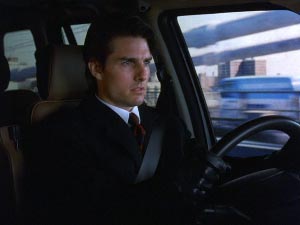 419 |
 420 |
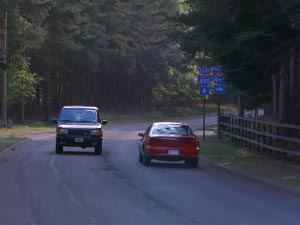 421 |
421 LS Crossfade to a country street. (1:48:44 begin crossfade, end at 1:48:47.) Bill drives toward the camera, a red car passing on his right.
In Section Five I've already written on Somerton's possible relationship to the fabled labyrinths of Troy and Jericho, and how we see a sign for State Highway 106 that runs through Jericho. New York isn't the location for the exterior shots of the gate supposedly outside Somerton, these would have been filmed in England, the foliage isn't similar to New York. Somerton is believed to be reached through Jericho, and comes after Bill having been driven through Oyster Bay on what is called the Gold Coast. But we have to instead be close to Interstate 495 as we see signs for it. Jericho is close to 495.
Entering a forested area, he passes a sign that reads that 495 East is ahead, in the opposite direction from which he is driving, and 495 West is to the right.
Bill is approaching Somerton from the opposite direction he arrived in via the taxi.
We hear birds as the car engine shuts off.
The Musica Ricercata plays.
Bill steps out of the car and approaches the gate.
422 MS Bill through the gate. (1:49:13)
The gate, which is much the same blue, when lit, as the cloaks worn by the two attendants beside the red-cloaked man the night before, has changed and will remain changed through the rest of the scene. See the pic at shot 427 for how the gate has changed and compare with shot 272.
Looking up, he notices on one of the gate posts the security camera which turns and follows him.
423 MS The security camera. (1:49:26)
424 MS Bill through the gate. (1:49:30)
He watches the camera.
425 MS The camera. (1:49:38)
Zoom in on the camera, which reminds of HAL from 2001.
426 MS Bill through the gate. (1:49:40) Bill hears a car.
 422 |
 423 |
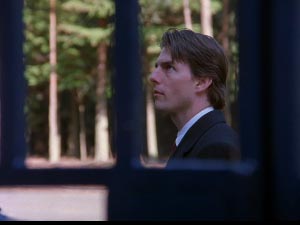 424 |
 425 |
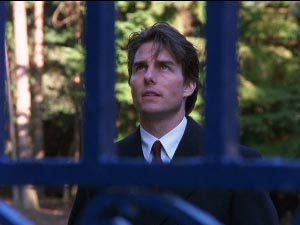 426 |
|
427 LS The drive beyond the gate from Bill's left. (1:49:49)
Bill watches a car from beyond a bend.
Same road, same landscape, but the gate has changed. It looks much the same but the shorter ornate bars between the longer ones are gone, and there are other differences. This could be explained away perhaps by Kubrick not wanting the partial, shorter bars that had been between the long upper bars to interfere with our seeing through the gate in these shots. But I would imagine that would have been thought out early on. Instead we have two different gates. I think the fact we have two different types of latches used on this side of the gate also supports this being a purposeful change.
The wave in the road repeats the wave reception desk at Bill's office, ending in the tree. As I've said, Somerton is no "real" place, at least not for purposes of the deeper story. We have the same wave road that takes us into the evergreens of the Going-to-the-Sun Road and ultimately toward the Overlook in The Shining.
428 MS Bill through the gate. (1:49:56)
429 LS The drive beyond the gate. (1:49:57)
He watches the car approach on the other side of the gate, license plate BQR 123.
430 MS Bill through the gate. (1:50:09)
 428 |
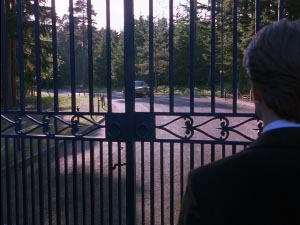 429 |
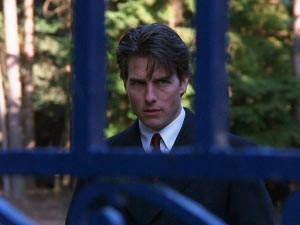 430 |
|
431 LS The drive beyond the gate. (1:50:13)
The car having parked, an older man gets out, advances toward the gate, and slips an envelope through to Bill.
We see that the right latch ring on the gate is twisted while the left one is not, which takes us back to the scene in Victor's bathroom wherein the lamp on the table beside Amanda at first had a twisted pedestal and then was changed to a straight one. When it had the twisted pedestal it was accompanied by the red phone. When it had the straight pedestal it was accompanied by, instead, the drug paraphernalia (spoon etc).
The envelope slipped through the gate to Bill.
Note that the gate is the same blue as are the postal drop boxes that have been standing out in the film since the previous night.
The envelope was prepared for Bill, as if his return visit had been anticipated.
The deliver of the envelope to Bill reminds also of the "perfectly honest" hotel clerk remembering to tell Bill the detail of Nick attempting to pass him an envelope, but this being prevented, and his being informed that messages would be collected by someone properly authorized. The clerk placing an envelope in an unmarked cubbyhole when Bill arrived at his desk, ties the events together so that, in a sense, Bill was the authorized individual to receive the information (the message) that the clerk had to give him in response to his inquiries. We could look at it this way, that Bill is the authorized person to receive this envelope at Somerton.
432 MS Bill through the gate. (1:50:37)
Bill takes the envelope from the man.
433 LS The drive beyond the gate. (1:50:58)
Without saying a word, the man returns to the car, gets in the passenger's side, and the car drives away.
434 MS Bill through the gate. (1:51:08)
435 MCU The envelope. (1:51:16)
The envelope is addressed Dr. William Harford. The note inside reads,
Give up your inquiries which are completely
useless, and consider these words a second
warning.
We hope, for your own good, that this will be
sufficient.
The observed letters on the license plate of the car were BQR. BQR, in Hebrew, means "to inquire, make search".
Recollect also that the "ricercata", the music, which is playing, means "to seek".
Once again, the gate is closed to Bill. He's denied admittance.
436 MS Bill through the gate. (1:51:36)
Bill turns and walks away.
 432 |
 433 |
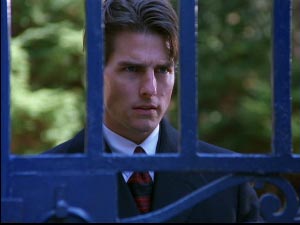 434 |
 435 |
 436 |
|
tl;dr.
Then you missed the part about the yellow executioner's chair.
Approx 12,500 words or 26 single-spaced pages. A 96 minute read at 130 wpm.
Next: Go to Part 7 of the analysis
Go to Table of Contents for Analysis of Eyes Wide Shut
Link to the main TOC page for all the analyses










